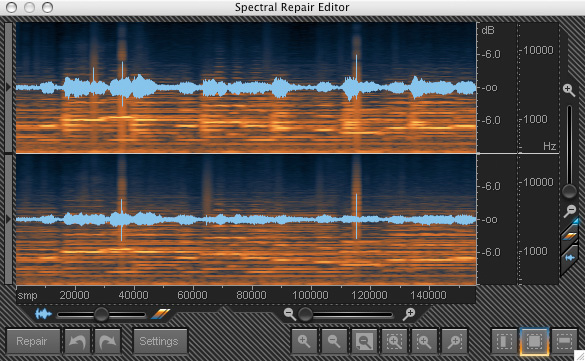When to use Declicker
- Izotope Rx 3 Declicker Vs Rx 6 Mouth Declick 2
- Izotope Rx 3 Declicker Vs Rx 6 Mouth Declick Cleaner
- Izotope Rx Declip
- Izotope Rx Mouth Declick
- Izotope Rx 3 Declicker Vs Rx 6 Mouth Declick Device
The Mouth De-click audio plug-in and module in iZotope RX 8 is a de-clicker that is finely tuned to detect and reduce mouth noises such as clicks and lip smacks. It's designed for use on longer audio selections, but it can be used to remove individual clicks. Izotope Rx 3 Declicker Vs Rx 6 Mouth Declick Treatment When an audio signal contains many clicks close together, often lower in volume, this is described subjectively as crackle. De-crackle is very effective at removing these types of audio problems, often after De-click has removed the worst offending clicks. J7n 15 February 2017 at 6 h 13 min “Izotope RX” is very good at removing clipping and is relatively safe to use on a wide range of programs. The plugin is unlikely to make the sound worse, since it affects only samples with level above the set threshold, and the rest are passed through untouched.
- The De-click plug-in and module in iZotope RX automatically identifies and removes clicks, pops, and digital impulse noises that can ruin a listening experience. Use De-click when polishing audio transfers and other recordings suffering from quality degradation, digital errors, cell phone interference, and more with the low-latency De-click.
- For the first 10 days after installation, RX will run in Trial mode, which offers full functionality with the exception of saving and batch processing. After 10 days, RX will revert to Demo mode. In Demo mode, RX is limited to 30 seconds of continuous playback.
Izotope Rx 3 Declicker Vs Rx 6 Mouth Declick 2

Izotope Rx 3 Declicker Vs Rx 6 Mouth Declick Cleaner
Declicker is useful for restoring for old vinyl and other phonograph recordings that are riddled with clicks, pops and crackles. Declicker can also remove a variety of short impulse noises from other sources, including some clicks caused by digital errors.
Automatic or Manual Declicking?
Declicker features both Manual and Automatic modes. Automatic mode can look at a whole file, or a selection, and detect and remove clicks and pops. For audio files that have clicks and pops throughout the file, Automatic declicking is the best choice as it will save you a lot of time. The Manual declick mode is useful when you want more precise control over repairing clicks, or in some cases where there are a few hard to fix clicks left over after running the Automatic declick mode. Manual declicking must be performed on each event individually.
Using Automatic Mode
When using the Automatic mode, start by setting the Maximum Click Width control, then adjust the sensitivity control to fine tune click attenuation. Before running declicker in automatic mode, it is a good idea to look at the Spectrogram display and visually identify clicks to inspect how wide they are, as this will help you see roughly what your Maximum Click Width and sensitivity should be set to.
Izotope Rx Declip

Hit preview to hear the result of your settings, and as audio is playing back, fine tune the sensitivity and click width sliders to remove the most clicks and pops. The ideal setting should remove the most clicks without damaging transients in the program material. For example, drum hits may be mistaken for clicks at high Width and Sensitivity settings.

To better hear what is being removed, toggle the Output Clicks Only control during preview playback. This will let you hear what is being removed from the audio, allowing you to fine tune your settings.
Note: for material with clicks and pops of very different sizes, try running Declicker in several passes. Start with repairing short clicks, and then continue to longer ones.
Using Manual Mode
To locate clicks, display both waveform and spectrogram by dragging the waveform/spectrogram transparency slider to the center. Clicks will be visible as vertical lines on the spectrogram. To select a click precisely, zoom in and inspect the waveform. While spectrogram will help with finding clicks, the waveform display will help you accurately select click boundaries.
Izotope Rx Mouth Declick
Select the click and press Apply. The click will be removed using interpolation from the surrounding audio data. If the result is not satisfactory, try adjusting Interpolation Order or other parameters. If the click or pop is very long, Declicker may cause a short level drop. In this case, consider using the Spectral Repair tool instead of Declicker.Read more about Declicker controls in the Reference Guide.